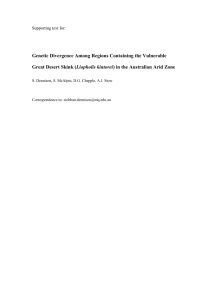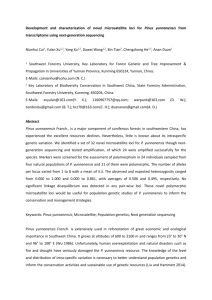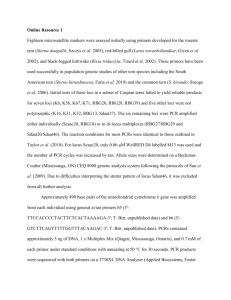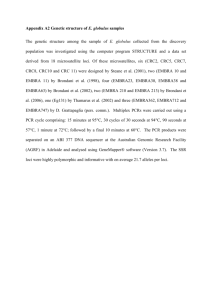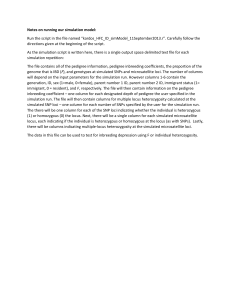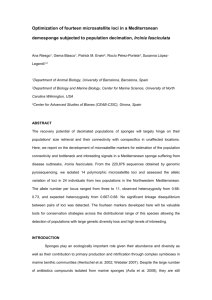Isolation and characterization of twenty novel microsatellite loci in
advertisement
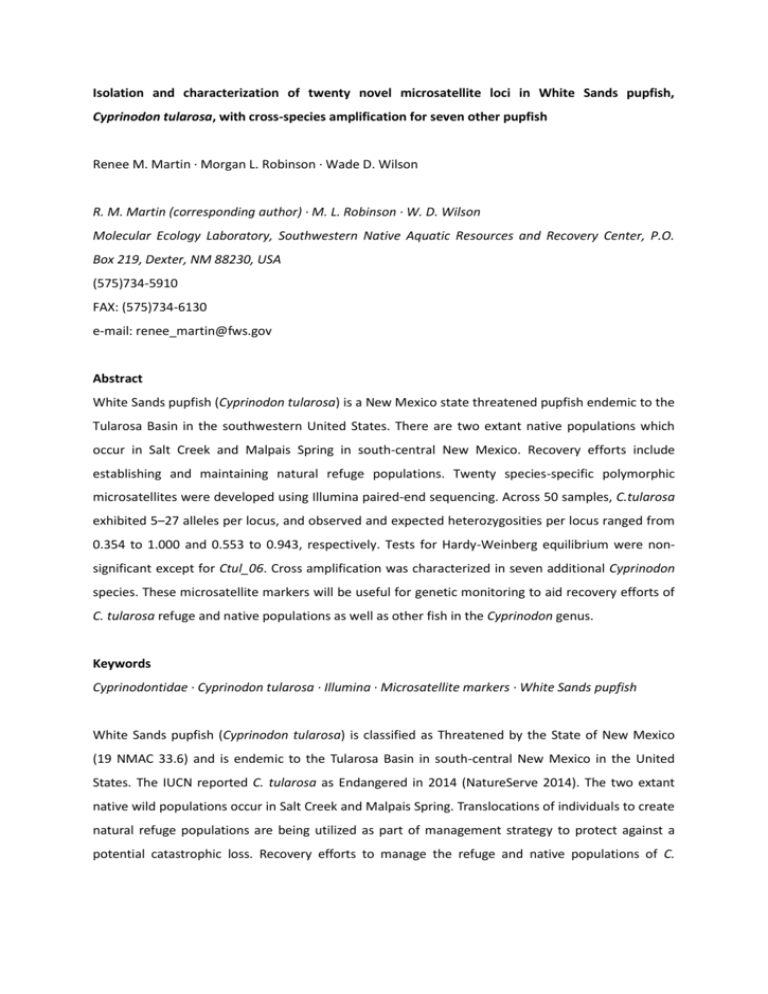
Isolation and characterization of twenty novel microsatellite loci in White Sands pupfish, Cyprinodon tularosa, with cross-species amplification for seven other pupfish Renee M. Martin ∙ Morgan L. Robinson ∙ Wade D. Wilson R. M. Martin (corresponding author) ∙ M. L. Robinson ∙ W. D. Wilson Molecular Ecology Laboratory, Southwestern Native Aquatic Resources and Recovery Center, P.O. Box 219, Dexter, NM 88230, USA (575)734-5910 FAX: (575)734-6130 e-mail: renee_martin@fws.gov Abstract White Sands pupfish (Cyprinodon tularosa) is a New Mexico state threatened pupfish endemic to the Tularosa Basin in the southwestern United States. There are two extant native populations which occur in Salt Creek and Malpais Spring in south-central New Mexico. Recovery efforts include establishing and maintaining natural refuge populations. Twenty species-specific polymorphic microsatellites were developed using Illumina paired-end sequencing. Across 50 samples, C.tularosa exhibited 5–27 alleles per locus, and observed and expected heterozygosities per locus ranged from 0.354 to 1.000 and 0.553 to 0.943, respectively. Tests for Hardy-Weinberg equilibrium were nonsignificant except for Ctul_06. Cross amplification was characterized in seven additional Cyprinodon species. These microsatellite markers will be useful for genetic monitoring to aid recovery efforts of C. tularosa refuge and native populations as well as other fish in the Cyprinodon genus. Keywords Cyprinodontidae ∙ Cyprinodon tularosa ∙ Illumina ∙ Microsatellite markers ∙ White Sands pupfish White Sands pupfish (Cyprinodon tularosa) is classified as Threatened by the State of New Mexico (19 NMAC 33.6) and is endemic to the Tularosa Basin in south-central New Mexico in the United States. The IUCN reported C. tularosa as Endangered in 2014 (NatureServe 2014). The two extant native wild populations occur in Salt Creek and Malpais Spring. Translocations of individuals to create natural refuge populations are being utilized as part of management strategy to protect against a potential catastrophic loss. Recovery efforts to manage the refuge and native populations of C. tularosa will be assisted by genetic monitoring utilizing data from polymorphic microsatellite markers. Genomic DNA was extracted from C. tularosa fin clips using Qiagen DNeasy Blood and Tissue Kit. Illumina paired-end sequencing and primer design were completed by the University of Georgia’s Savannah River Ecology Laboratory in Aiken, SC. An Illumina paired-end shotgun library was prepared by shearing 1 µg of DNA using a Covaris S220 and following the standard protocol of the Illumina TruSeq DNA Library Kit and using a multiplex identifier adaptor index. Illumina sequencing was conducted on the HiSeq with 100 bp paired-end reads. Five million of the resulting reads were analyzed for microsatellites with the program PAL_FINDER_v0.02.03 (Castoe et al. 2012). Primer3 (version 2.0.0) was used for primer design. To avoid issues with copy number of the primer sequence in the genome, loci for which the primer sequences only occurred one or two times in the five million reads were selected. Forty-eight loci that met this criterion were screened. Twenty polymorphic microsatellite loci were optimized (Online Resources ESM_2). Samples were amplified via PCR using forward primers (Applied Biosystems) labeled with one of four fluorescent dyes (6-FAM, PET, NED, VIC). PCR amplification was carried out in 10 μL reactions consisting of 1 μL template DNA, 5 μl ddsH2O, 3 μl Qiagen Multiplex PCR Master Mix, and 0.5 μL each of forward and reverse 10 μM primers using a GeneAmp® PCR System 9700 (Applied Biosystems). Touchdown cycling (temperature decreased by 0.2ºC /cycle) consisted of one cycle at 95ºC for 15 min followed by 35 cycles of 95ºC for 45 s, annealing at 56ºC for 60 s, and 72ºC for 60 s with final extension at 72ºC for 30 min. Amplified microsatellite loci were visualized on an automated genetic analyzer (ABI 3130xl) with GeneScan™ Liz500 size standard and GeneMapper 5.0 software (Applied Biosystems). GenAlEx 6.3 (Peakall and Smouse 2006) was used to calculate the observed (Ho) and expected (He) heterozygosity and Hardy-Weinberg equilibrium (HWE). Across the twenty loci, C. tularosa exhibited 5–27 alleles per locus, and observed and expected heterozygosities per locus ranged from 0.354 to 1.000 and from 0.553 to 0.943, respectively (Table 1). Significant heterozygote deficiency (P < 0.05) in tests of Hardy-Weinberg equilibrium was observed for Ctul_06. Tests for linkage disequilibrium (LD) using GENEPOP (Raymond and Rousset 1995) showed significant LD in Ctul_034/Ctul_016 and Ctul_042/Ctul_015, both after Bonferroni corrections (Rice 1989). Cross amplification of the microsatellite loci were characterized for seven additional Cyprinodon species (Online Resources ESM_3). Acknowledgements We thank Evan Carson and Alexandra Snyder (University of New Mexico) for providing samples and the staff of Southwestern ARRC for comments. Funding for this project was provided by U.S. Fish and Wildlife Service (NMESFO). The findings and conclusions in this article are those of the authors and do not necessarily represent the views of the U.S. Fish and Wildlife Service. References Castoe TA, Poole AW, de Koning APJ, Jones KL, Tomback DF, Oyler-McCance SJ, Fike JA, Lance SL, Streicher JW, Smith EN, Pollack DD (2012) Rapid microsatellite identification from Illumina pairedend genomic sequencing in two birds and a snake. PLoS ONE 7:e30953 NatureServe (2014) Cyprinodon tularosa. In: IUCN 2014. IUCN red list of threatened species. Version 2014.3. www.iucnredlist.org Peakall R, Smouse PE (2006) GENALEX 6: genetic analysis in Excel. Population genetic software for teaching and research. Mol Ecol Notes 6:288–295. doi: 10.1111/j.1471-8286.2005.01155.x Raymond M, Rousset F (1995) GENEPOP (version 1.2): population genetics software for exact test and ecumenicism. J Hered 86:248–249 Rice WR (1989) Analyzing tables of statistical tests. Evolution 43:223–225
